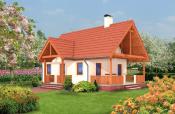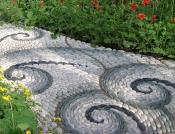Search
Login
Recommended
Lighting apartment. Lighting options for the hallway in the interior of a modern apartment, original tips and methods for installing lamps
Hallway - a room in a house or apartment, which should allow a person to quickly switch from an active working condition to a more calm and relaxed, inherent for a comfortable home environment. An important role in this is played by the lighting option used in the hallway. Since in most apartments the entrance hall is planned in such a way that there is no natural lighting in it, then throughout the day the owners have to resort to artificial lighting.
Content:
- We light the hallway correctly video
- The second light method is used in lighting the hallway video
- We use switches with sensors
- Narrow entrance hall and lighting options video
- Transform a small or polygonal hallway with lighting
- Private entrance hallway lighting options
- How to light a windowless hallway
- Ways of mounting fixtures
- Hallway Lighting Design
- Mirror and its lighting
We light the hallway correctly

Psychologists believe that even a short stay of a person in the hallway with poor lighting can have a negative effect on the human psyche, as a result of which the guest’s opinion about the whole apartment will be negative. At the same time, correctly selected lamps and their rational arrangement immediately create a positive mood and a desire to get to know the house more closely.
Sometimes the layout of an apartment or house involves the constant movement of residents through the hallway, if necessary, move from one room to another. In this case, you will need to take care of installing an additional light source in the form of a table lamp or a beautiful fluorescent lamp. The main thing is to find a suitable place for them.
The second light method is used in lighting the hallway

In the hallway, which one often has to visit, the second light method is often used as additional lighting. The principle of this method is that light enters the hallway due to glass interior doors or walls with mirrors. When solving this issue, the well-proven partitions with glass blocks perfectly help. One who is aware that this material is not only decorative, but much functional, will never lose.
We use switches with sensors
There are times when it will be more rational to illuminate the hallway with lamps, the control of which will not be ordinary switches, but with the help of switches equipped with sensors that respond to heat or movement. The main advantage of such sensors is automatic inclusion when a person appears in the field of action. A correctly installed reacting element is switched on only at a certain height, therefore, there will be no reaction to the movement of pets. It is also permissible to use circuits with switches from two points, provided that the corridor is long.

Unfortunately, when planning an apartment for the hallway, there is not much space left. In addition, the area left is not always regular or convenient in shape. It can be either very tall and narrow, or too elongated, or very tight. Even in cases where there is enough space in the hallway, often its walls are cut by the same doorways or voids of the same type.
Sometimes they try to dilute the monotony of the walls of the hall with paintings, draw up artificial niches or ledges, and correct unfavorable proportions with various design moments, for example, openwork partitions or arches. Of course it is beautiful and interesting, but you can get by with non-standard and at the same time extravagant means. In other words, correct flaws with the help of light. It is known that light can do wonders - a small room is visually much more spacious, too narrow - to expand a little, and the secluded, dark corners highlighted by light will look much more attractive and interesting.
Narrow entrance hall and lighting options

In order to adjust the long and narrow entrance hall, the method of enhanced and saturated wall lighting should be used. The tactics of this method of lighting the ceiling in the hallway are as follows - powerful lamps are hung throughout the room, light beams are sent to the walls. A large amount of light received, which is reflected from the ceiling and from the top of the walls, will ghostly dissolve the surface. The location of the fixtures can be on the ceiling and on the walls. The main point of lighting a narrow hallway is the correct orientation of the rays of light, that is, on the necessary details of the interior or design.
If the ceiling height is too high, you can use wall lights for adjustment. Also, fixtures on the ceiling with a variable angle of rotation will be appropriate. The rays of light from the lamps should be directed exactly at the walls. In this case, the ceiling will remain shaded and visually decrease.
Transform a small or polygonal hallway with lighting
In complex polygonal hallways, the light zoning method will work fine. All turns and angles illuminate at different angles and different light sources. The places so illuminated take on the appearance of individual islands of decor along the way into the interior of the apartment. For an interesting design of such a hall, a lot of imagination is not required. It will be enough to attach a small sconce near the mirror, light a panel on the wall or a small chair with a floor lamp and you will be surprised how much your hallway will be transformed.
For those striving for non-standard, impressive solutions, we suggest placing light points not to create camouflage when lighting a small hallway, but rather, to reveal more and increase reality. For example, you can increase the long and narrow hallway by mounting a series of identical downlight fixtures on the ceiling, the unusual lighting of a small hallway will transform its interior beyond recognition.
It makes sense to equip the entrance hall with two different types of lighting. One of which will serve for general lighting, and the second will be more functional - it will serve to illuminate some more specific goals, objects, details.
Private entrance hallway lighting options

Hallways in private, large, expensive homes are usually large and split-level. Usually a staircase is also located in this space. Provided that the top of the hallway collides with the roof - you can arrange a light lamp or an anti-aircraft lamp on the ceiling - a window located on the ceiling that has any desired shape from the most ordinary to a fancifully intricate one. From early morning until evening, soft natural light will enter the entrance hall from this window opening, falling into the most secluded corners. Of course, with the advent of darkness, additional lighting will be necessary, but at the same time, during the daytime, energy will be saved.
How to light a windowless hallway

Typically, in apartment buildings, there are no window openings in the hallways. In such a space, experts advise opening a limited area by resorting to simulating the outgoing light from surfaces. For example, around the perimeter in the hallway, hiding behind the ledge to mount fluorescent lamps. You can also make a half-transparent, light-transmitting suspended ceiling, and attach lights to it. To date, there are even ready-made designs with lamps on sale. If desired, you can consider this option of lighting in the hallway.
Ways of mounting fixtures

In hallways and corridors, fixtures are mounted on structures that conduct current. For such rooms, it is advised to purchase closed models of luminaires with uniform light scattering. In the worst case, light scattering should occur as low as possible.
Luminaires located in the very center of the ceiling should diffuse soft streaming light. Lamps shining exactly on the floor, provided there is not a high ceiling - should not light compact hallways. Follow the advice - using spotlights, install only those models on which you can adjust the angle of rotation, as well as they need to be grouped along the walls.
Hallway Lighting Design

The most acceptable option for lighting the hallway would be wall lights. Sconces are applicable in rooms with high and low ceilings, but they should be placed so that the light is higher than the eye level of people entering the room. Other nuances can be considered less important - light can propagate down the walls or along the sides. But its main spreading should still occur on the ceiling and the upper part of the walls. You should also know that a closer location of the lamp to the wall will allow you to see in more detail each of the flaws present on its surface. In other words, the light from the side illuminates the texture of the wall. From this we must conclude - the finish should be done as smoothly and neatly as possible.
Wall mounted lamps are excellent for lighting the area under consideration. Such designs are similar to portholes and give the hallway, in addition to winning lighting, the effect of vagueness and mystery.
Of course, wall sconces can be very diverse in form and materials of manufacture, but the installation rules are quite specific and unshakable.

It is recommended to fix them at a height of about two meters. Thus, the light will be concentrated higher than the possible presence of a human head. But in some individual cases or with special need, the lamps are lowered closer to the floor or raised higher to the ceiling.
Mirror and its lighting

Special attention should be paid to the mirror located in the hallway. It should have dimensions that allow a person to see himself at full height, and being at a certain distance. To improve the quality of the display, lighting should meet the following requirements: be bright enough, local, not irritate the eyes of a person when trying to view the display. Therefore, it is recommended to place the lamps so that the light emitted by them does not contribute to the appearance of shadows. Usually, halogen lamps with good color rendering are used for this purpose.
Lighting points are placed depending on the dimensions of the mirror. The most convenient place will be the upper part of the frame for the mirror, of course, provided that it is located no higher than two meters from the floor. A higher mirror is often illuminated by symmetrically arranged luminaires, at approximately the same distance.
In a large entrance hall, a lighted mirror harmoniously complements the main light. But in the opposite, it will fulfill the tasks of general lighting.
Since the illumination around the mirror belongs to the working class, technical characteristics will be important when buying lighting devices. Decorative moments will fade into the background. It will be optimal to opt for luminaires of uncomplicated shape, giving not very strong light. In such cases, direct light is also acceptable, but subject to the condition that it does not interfere with the one looking in the mirror.





